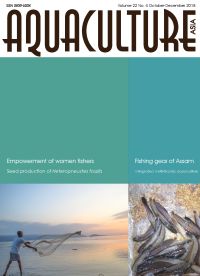Integrated multi-trophic aquaculture systems: a solution for sustainability
4 October 2018 | Kapil S. Sukhdhane, V. Kripa, D. Divu, Vinay Kumar Vase and Suresh Kumar Mojjada | 4828 Downloads | .pdf | 397.16 KB | Aquatic plants, India, Marine finfish, Molluscs (shellfish and other), Nutrition and feeding, Environment and Sustainability
Marine aquaculture of high value species such as fish is generally reliant on external food supplies and has a negative impact on water quality, generating high organic and nutrient loadings, mainly from feed wastage and excretion. There may be negative impacts on benthic environments from smothering and increased organic enrichment. Many attempts to reduce nutrient loading from fish farms have been made, such as by improving the digestibility of fish feeds, but technological improvements have not eliminated the problem of nutrient pollution.
One solution to reducing the environmental impact of fish farming is the use of integrated multi-trophic aquaculture. By culturing complimentary species, wastes from one compartment may be used as inputs, whether feed or fertiliser, for other compartments, effectively recycling nutrients and reducing nutrient pollution while generating additional products for sale. This article looks at species selection and integration of trophic levels in system design.
Creative Commons Attribution.

